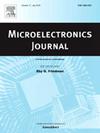Design of lightweight on-chip one-dimensional convolutional neural network accelerators for edge-end chips
IF 1.9
3区 工程技术
Q3 ENGINEERING, ELECTRICAL & ELECTRONIC
引用次数: 0
Abstract
One-dimensional convolutional neural networks (1D-CNNs) play a crucial role in edge computing applications. To address the challenges of deploying 1D-CNNs on edge devices, this paper proposes a lightweight on-chip 1D-CNN accelerator and its corresponding compilation and deployment process for edge-end chips. The proposed accelerator architecture features an innovative two-stage storage structure, a configurable multiplier-adder tree array, and a comparator array, with an integrated CORDIC core to enhance support for various 1D-CNN architectures. The compilation and deployment process supports operator conversion and fusion, increasing circuit utilization and reducing memory access demands. The accelerator was synthesized using the Global Foundries 22 nm process, achieving a peak throughput of 5.8 GOP/s and a power efficiency of 823.4 GOP/s/W at 200 MHz with an area of 0.056 mm2. Comparative testing showed that the proposed design's average computation delay and energy efficiency are 0.520 and 0.145 times that of the ARM Cortex-M7, respectively, demonstrating the proposed accelerator's superior performance and energy efficiency.
求助全文
约1分钟内获得全文
求助全文
来源期刊

Microelectronics Journal
工程技术-工程:电子与电气
CiteScore
4.00
自引率
27.30%
发文量
222
审稿时长
43 days
期刊介绍:
Published since 1969, the Microelectronics Journal is an international forum for the dissemination of research and applications of microelectronic systems, circuits, and emerging technologies. Papers published in the Microelectronics Journal have undergone peer review to ensure originality, relevance, and timeliness. The journal thus provides a worldwide, regular, and comprehensive update on microelectronic circuits and systems.
The Microelectronics Journal invites papers describing significant research and applications in all of the areas listed below. Comprehensive review/survey papers covering recent developments will also be considered. The Microelectronics Journal covers circuits and systems. This topic includes but is not limited to: Analog, digital, mixed, and RF circuits and related design methodologies; Logic, architectural, and system level synthesis; Testing, design for testability, built-in self-test; Area, power, and thermal analysis and design; Mixed-domain simulation and design; Embedded systems; Non-von Neumann computing and related technologies and circuits; Design and test of high complexity systems integration; SoC, NoC, SIP, and NIP design and test; 3-D integration design and analysis; Emerging device technologies and circuits, such as FinFETs, SETs, spintronics, SFQ, MTJ, etc.
Application aspects such as signal and image processing including circuits for cryptography, sensors, and actuators including sensor networks, reliability and quality issues, and economic models are also welcome.
 求助内容:
求助内容: 应助结果提醒方式:
应助结果提醒方式:


